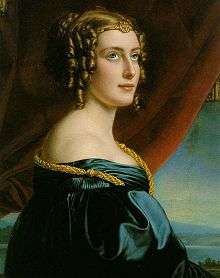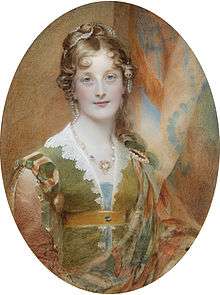Jane Digby
| Jane Digby | |
|---|---|
 Portrait of Digby by Joseph Karl Stieler (1831) | |
| Born |
Jane Elizabeth Digby 3 April 1807 Minterne Magna, Dorset, England, United Kingdom |
| Died |
11 August 1881 (aged 74) Damascus, Syria |
| Cause of death | Fever and Dysentery,[1] |
| Resting place | Damascus, Syria |
| Other names |
Jane Elizabeth Digby el Mezrab Shaikhah Umm al-Laban |
| Title | Lady Ellenborough |
| Spouse(s) |
Baron Karl von Venningen (m. 1833; div. 1842) Spyridon Theotokis (m. 1841; div. 1846) Medjuel el Mezrab (m. 1853; her death 1881) |
| Parent(s) |
Admiral Sir Henry Digby Lady Jane Elizabeth |
Jane Elizabeth Digby, Lady Ellenborough (3 April 1807 – 11 August 1881) was an English aristocrat, famed for her love life and life style. She had four husbands and many lovers, including King Ludwig I of Bavaria, his son King Otto of Greece, statesman Felix Schwarzenberg, and a Greek general (Christodoulos Hatzipetros). She died in Damascus, Syria, as the wife of Arab Sheikh Medjuel el Mezrab, who was 20 years her junior.[2]
Life
Jane Elizabeth Digby was born in Forston House, near Minterne Magna, Dorset on 3 April 1807,[3] daughter of Admiral Henry Digby and Lady Jane Elizabeth. Jane's father seized the Spanish treasure ship Santa Brígida in 1799 and his share of the prize money established the family fortune.
Marriages, scandal, and affairs
Considered promiscuous for her times, Digby was first married to Edward Law, 2nd Baron Ellenborough (later Earl of Ellenborough), who became Governor General of India, on 15 October 1824. They had one son, Arthur Dudley Law (15 February 1828 – 1 February 1830), who died in infancy.
After affairs with her maternal cousin, Colonel George Anson, and Prince Felix Schwarzenberg, she was divorced from Lord Ellenborough in 1830 by an act of Parliament. This caused considerable scandal at the time. Digby had two children with Felix; Mathilde "Didi" (born 12 November 1829 Basel and raised by Felix's sister) and Felix (born December 1830 Paris) who died just a few weeks after his birth. The affair with Felix ended shortly after the death of their son.
She then moved on to Munich and became the lover of Ludwig I of Bavaria. In Munich, she met Baron Karl von Venningen (6 January 1806 – 10 June 1874). They married in November 1833 and had a son, Heribert (27 January 1833 Palermo-1885 Munich), and a daughter, Bertha (4 September 1834 Mannheim-22 September 1907).
In 1838, Digby found a new lover in the Greek Count Spyridon Theotokis (born 1805). Venningen found out and challenged Theotokis to a duel, in which the latter was wounded. Venningen generously released Digby from the marriage and took care of their children. They remained friends for the rest of their lives.
Though she was not legally divorced from Venningen until 1842, Digby converted to the Greek Orthodox faith and married Theotokis in Marseille in 1841. The couple moved to Greece with their son Leonidas (21 March 1840 Paris-1846 Athens). In 1846, after their son's fatal fall off a balcony, Theotokis and Digby divorced. Greece's King Otto became her next lover.
Next came an affair with a hero of Greek revolution, Thessalian general Christodoulos Chatzipetros,[4] acting as 'queen' of his army, living in caves, riding horses and hunting in the mountains. She walked out on him when he was unfaithful.
Life in Syria

At age forty-six, Digby traveled to the Middle East, and fell in love with Sheik Medjuel el Mezrab. (The sheik's name has also been spelled as "Mijwal al Mezrab"[5] and as "Mijwal al-Musrab." Twentieth-century sources[6] sometimes incorrectly report it as "Abdul Medjuel el Mezrab.") Medjuel was a sheik of the Mezrab section of the Sba'a, a sub-tribe of "the great Anizzah tribe of Syria."[7] He was twenty years her junior.[8] The two were married under Muslim law and she took the name Jane Elizabeth Digby el Mezrab. Their marriage was a happy one and lasted until her death twenty-eight years later. It has been written that Jane Digby was referred to as Shaikhah Umm al-Laban (literally sheikha mother of milk) due to the colour of her skin.
Digby adopted Arab dress and learned Arabic in addition to the other eight languages in which she was fluent. Half of each year was spent in the nomadic style, living in goat-hair tents in the desert, while the rest was enjoyed in a palatial villa that she had built in Damascus. She spent the rest of her life in the city, where she befriended Richard and Isabel Burton while the former was serving as the British consul, and Abd al-Kader al-Jazairi, a prominent exiled leader of the Algerian revolution.
Death
Digby died of fever and dysentery in Damascus on 11 August 1881, and was buried in the Protestant Cemetery. She was buried with her horse in attendance at the funeral.[9] Upon her footstone – a block of pink limestone from Palmyra – is her name, written in Arabic by Medjuel in charcoal and carved into the stone by a local mason.[10] After her death her house was rented and the family of the young H. R. P. Dickson were among its tenants. A small part of the house still survives today, still in the ownership of the same family who purchased it from Medjuel's son in the 1930s.[11]
References
- Notes
- ↑ Lovell, Mary S: A Scandalous Life p.236 ,
- ↑ Keenan, Brigid (2000). Damascus Hidden Treasures of the Old City. Thames & Hudson Inc. p. 167. ISBN 0-500-28299-4.
- ↑ Mary S Lovell A Scandalous Life page 1
- ↑ [ Γιάννης Καιροφύλλας: «Η Αθήνα και οι Αθηναίοι» (1834–1934), τόμος πρώτος, σελ. 46 – 47, γ΄ έκδοση, Εκδόσεις Φιλιππότη, Αθήνα, 1983.]
- ↑ Walter Phelps Dodge. The Real Sir Richard Burton. T. Fisher Unwin, London, 1907. Page 75.
- ↑ For example, Stella Margetson in Leisure and Pleasure in the 19th Century (1969), page 138.
- ↑ "Going down the history lane - II", blog post by Ahmad Alsarraf, kalamanas.com, 2017-04-19. (This might be a circular reference to Wikipedia.)
- ↑ Lovell A Scandalous Life p. 173
- ↑ http://muslimmedianetwork.com/mmn/?p=12041
- ↑ Mary S Lovell, A Scandalous Life p. 326
- ↑ Mary S Lovell A Scandalous Life p. 326
- Sources
- Mary S. Lovell (1998). A Scandalous Life: A Biography of Jane Digby. Fourth Estate. ISBN 1-85702-469-9.
- Ure, John (2004). In Search of Nomads. Constable and Robinson. ISBN 1-84529-082-8.
- Bedell Smith, Sally (1996). Reflected Glory. The Life of Pamela Churchill Harriman. Simon and Schuster. ISBN 0-684-80950-8.